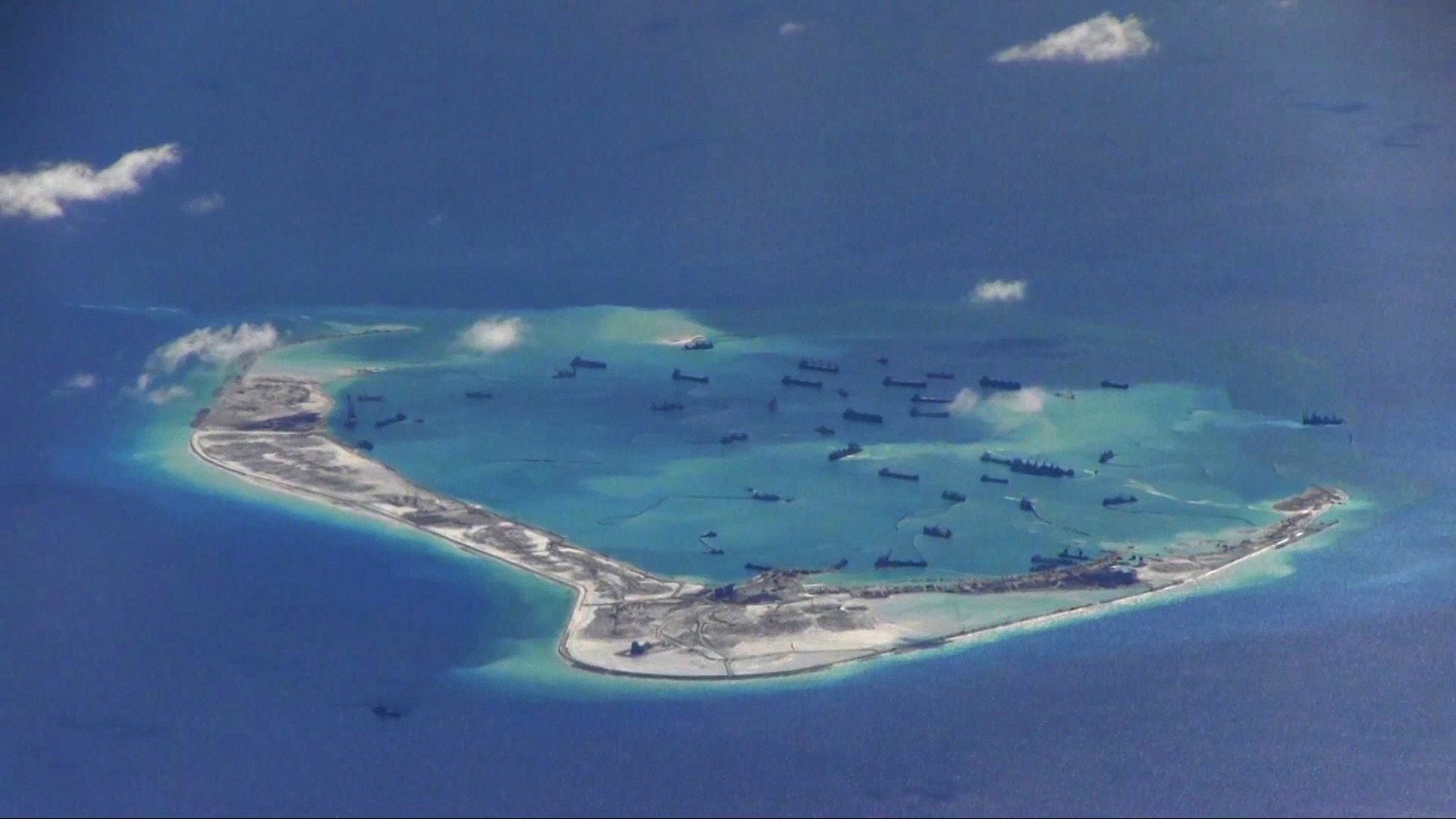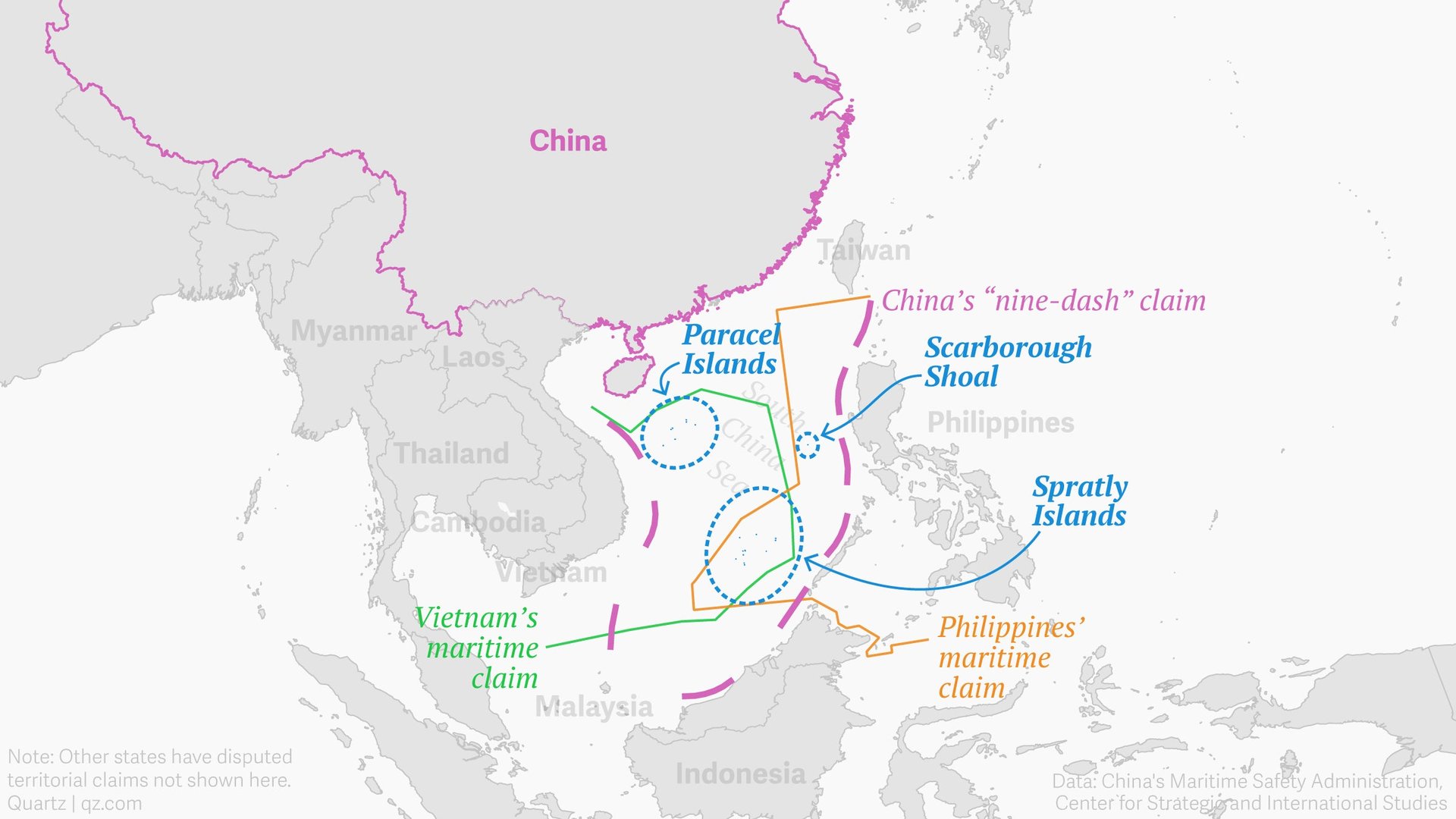China has no respect for international law, its neighbors, or marine life, a tribunal rules
A long-awaited international tribunal ruling issued today (July 12) dealt a heavy blow to China’s sweeping territorial claims in the South China Sea. The ruling paints a picture of an environmentally destructive, dangerously aggressive government that has no legal jurisdiction for its actions.


A long-awaited international tribunal ruling issued today (July 12) dealt a heavy blow to China’s sweeping territorial claims in the South China Sea. The ruling paints a picture of an environmentally destructive, dangerously aggressive government that has no legal jurisdiction for its actions.
The tribunal’s findings will have far-reaching impacts. The ruling essentially squashes any justification China might have had for harassing ships passing by its controversial artificial islands, blocking Filipino fishermen from areas like Scarborough Shoal, or interfering with other nations’ attempts to explore for oil off their coasts.
Indeed the tribunal ruled that China’s nine-dash line is essentially illegal and without basis under the 1982 UN Convention on the Law of the Sea (UNCLOS), which is at the core of modern maritime law and has been signed by over 160 nations (including China). The treaty for instance grants exclusive economic zones (EEZs) to coastal nations extending 200 nautical miles from the shore baseline, giving them sole exploitation rights over all natural resources in that zone.
Below are some of the main points of the 500-page “award” issued by the Permanent Court of Arbitration, in The Hague:
- China’s “claims to historic rights, or other sovereign rights or jurisdiction” related to the “nine-dash line” are unlawful, the tribunal found, “to the extent that they exceed the geographic and substantive limits of China’s maritime entitlements” under UNCLOS. The treaty supersedes “any historic rights or other sovereign rights or jurisdiction” and there was “no evidence that China has historically exercised exclusive control over the waters or their resources.”
- China built a large artificial island on Mischief Reef, a low-tide elevation located in the EEZ of the Philippines. The construction “caused permanent, irreparable harm to the coral reef ecosystem and permanently destroyed evidence of the natural condition of the features in question.” The project infringed the Philippines’ sovereign rights in its EEZ and continental shelf.
- China has prevented the Philippines from using non-living natural resources and fishing in the waters that lie within 200 nautical miles of its EEZ, infringing on the country’s sovereign rights. China’s People’s Liberation Army protected its own fishermen in the Philippines economic zone, while blocking Filipino fishermen from traditional waters—at one point rigging together 28 utility boats to prevent others from entering a shoal.
- Chinese fishermen have been harvesting endangered species including corals, sea turtles, and sharks at at least two shoals in the Spratly Islands—and Beijing has tolerated and protected these activities. In addition, China’s artificial island-building program at seven reefs in the Spratly Islands has caused “devastating and long-lasting” damage to the marine environment. For instance, 60% of the shallow reef habitat at the seven reefs has been directly destroyed, a 2016 study found.
- China sent law enforcement ships into the sea surrounding the Scarborough Shoal, creating “serious risk of collision and danger” to Philippine vessels and personnel. In some cases, these Chinese ships passed the Filipino ships at distances of 100 or fewer yards (91 meters), almost “ramming” one ship.
- The tribunal agreed with the Philippines that Scarborough Shoal, Johnson Reef, Cuarteron Reef, and Fiery Cross Reef are high-tide features and that Subi Reef, Hughes Reef, Mischief Reef, and Second Thomas Shoal were submerged at high tide in their natural condition. (Low tide features have no territorial sea of their own, unless they are within a certain distance of a country’s mainland or undisputed island).
- Throughout the course of the proceedings, China “aggravated and extended the disputes” by “dredging, artificial island-building, and construction activities” in the areas in question.
It “goes without saying that both Parties are obliged to resolve their disputes peacefully and to comply with the Convention and this Award in good faith,” the ruling concludes.
China’s foreign-affairs ministry stated soon after the ruling was released that “the People’s Republic of China solemnly declares that the award is null and void and has no binding force.” Beijing has long maintained that it will ignore today’s ruling, and it refused to participate in the case at all. Indeed it resorted to insulting the tribunal, with state-controlled media recently describing the PCA as a “law-abusing tribunal” with “widely contested jurisdiction.”
But it might be hard for China to ignore a ruling that so thoroughly, and in such fine detail, discredits its position.
A long time coming
The Philippines filed its case with the international court in 2013, asking the tribunal to rule on various aspects of China’s sweeping claims.

In recent years China has been acting aggressively in the sea, justifying its actions based largely on the nine-dashed line, which first appeared in a map published in the 1940s (originally with 11 dashes). Beijing submitted the map to the United Nations in 2009 (pdf), saying that China had “sovereign rights and jurisdiction over the relevant waters as well as the seabed and subsoil.”
The Philippines and other nations immediately objected.
For the Philippines, tensions ratcheted up in 2012, when its navy apprehended Chinese fishing trawlers illegally operating at Scarborough Shoal—well within its EEZ. After a standoff between Chinese and Philippine forces, the US mediated a deal in which both sides were to pull back from the shoal while the dispute was negotiated. The Philippine forces left, but the Chinese ones remained, gaining control that they still have today.
Significantly, the tribunal ruled that none of the islands in the contested Spratly archipelago, nor Scarborough Shoal, generate an EEZ. Instead, the most that any “island” in question generates is a territory of 12 nautical miles.
To simplify a bit, any feature that in its natural state is under water at low tide is not an island. A feature that does jut above the water at high tide is considered an island. But if it’s just a rock, it generates nothing more than a territorial sea of 12 nautical miles. If it’s a “real” island capable of sustaining human habitation or economic life of its own, it might generate an EEZ. Under the law, these determinations are made based on the natural state of the feature—regardless of what’s been built on top of them.
Leading up to the ruling China pushed for what it calls a “win-win” strategy in the sea (pdf, p. 19), where if other nations have oil and gas reserves that fall within both their own EEZs and China’s nine-dash line, then the two parties should share revenue on the project. Needless to say, other nations are not too keen on the idea (pdf, page 19). Now they have a ruling to cite showing they don’t need to share these resources with China.

Zheping Huang and Echo Huang Yinyin contributed reporting.